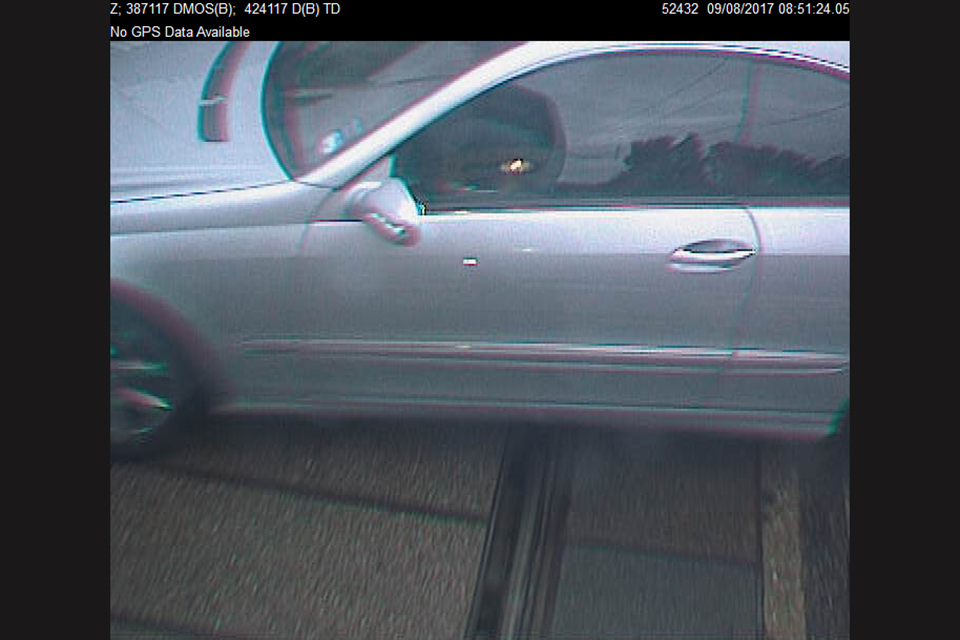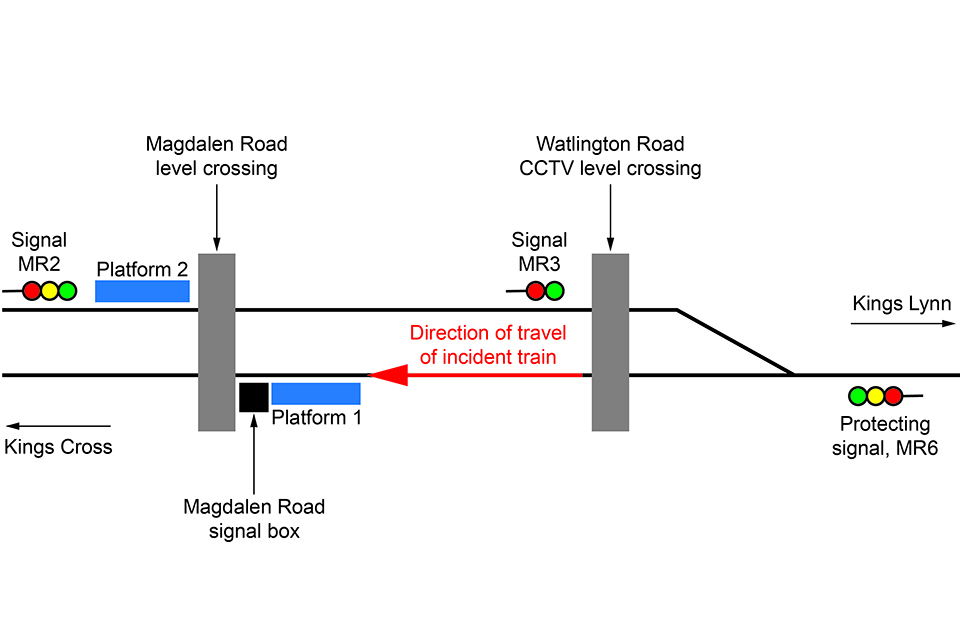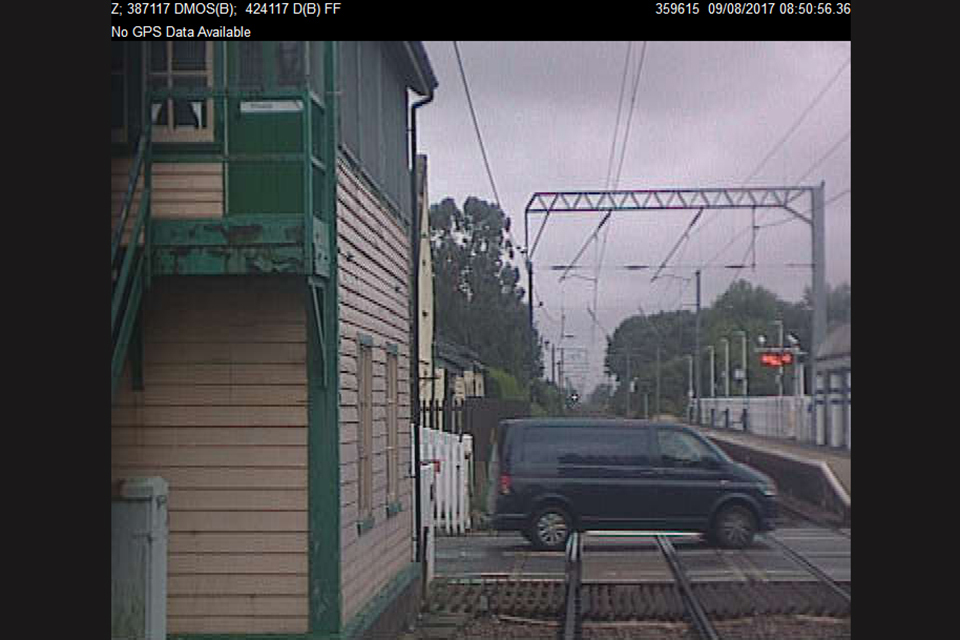Near miss at Magdalen Road level crossing, 9 August 2017
Published 19 October 2017
1. Important safety messages
This incident demonstrates the importance of:
- signallers ensuring that the route is and will remain safe for the passage of trains, when authorising a train to pass a signal at danger
- signallers placing level crossings controlled by the signal box in full manual control, when authorising a train to pass a protecting signal at danger
- signallers stopping and thinking before trying to recover from an unexpected event as there might be pitfalls in what seems to be an obvious course of action
- drivers actively monitoring the safety of the line ahead of their train after having been authorised to pass a signal at danger
2. Summary of the incident
At 08:51 hrs on 9 August 2017, a car traversed Magdalen Road level crossing at Watlington station immediately in front of a train, narrowly avoiding a collision. The crossing, controlled from the adjacent signal box, was open to road traffic at the time of the incident. The train, the 07:54 Kings Lynn to King’s Cross service operated by Govia Thameslink Railway, was travelling at low speed as it had just departed from Watlington station.
Neither the driver of the train, nor the driving instructor travelling with him, were aware of the near miss. The signaller in the adjacent signal box was also unaware of what had occurred. The incident was later reported by a member of the public travelling in a car following the one involved.

Forward facing CCTV footage showing a silver car straddling the crossing directly in front of the train (courtesy of Govia Thameslink Railway)
3. Cause of the incident
Magdalen Road level crossing was open to road traffic because the signaller in Magdalen Road signal box had not placed the crossing into manual control when authorising the approaching train to pass the protecting signal at danger (red).
The signaller in Magdalen Road signal box is responsible for lowering the barriers at Magdalen Road level crossing and ensuring that the crossing is closed to road traffic during the passage of trains. When a train approaches from Kings Lynn, the signaller first closes both Magdalen Road and Watlington Road level crossings to road traffic. He then looks to check that both crossings are clear of any obstruction (he checks Watlington Road level crossing by means of a CCTV monitor). When he is satisfied that both crossings are free of obstruction, he clears protecting signal MR6 which authorises the train to pass over both crossings. Once the train has passed over each crossing it will re-open automatically. The exception to this, is when the signaller has placed the crossing into manual control. Then the crossing will remain closed until manually re-opened. The railway at this location is a two-track railway and the same principles apply for a train approaching from King’s Cross.

Schematic diagram of platform layouts at Magdelen Road showing the crossing, the signal box and the signals.
On the day of the incident, the signaller was aware of disruptions to the normal service because of a track circuit failure in the Kings Lynn area. At 08:33 hrs, the signaller was advised that a train was approaching from Kings Lynn and at 08:41 hrs, he was also advised that another train was approaching from King’s Cross. In preparation for the arrival of the trains at the station, the signaller closed both crossings and tried to clear the protecting signals on both lines. Protecting signal MR2 for the train approaching from King’s Cross cleared normally allowing that train to enter platform 2. However, for reasons that are unknown, protecting signal MR6 for the train approaching from Kings Lynn did not clear.
The train from King’s Cross arrived at the station at 08:46:50 hrs. At 08:47:11 hrs, thinking that the problem with clearing MR6 signal was associated with the track circuit failure in the Kings Lynn area, the signaller called the driver of the train from Kings Lynn to authorise him to pass MR6 signal at danger. He instructed the driver to check the route, to be cautious over the points and to obey all other signals. At the time he started this call, the route for this train was safe as both level crossings were closed.
The driver of the train from King’s Cross completed his station duties and the train departed platform 2 at 08:47:24 hrs. At 08:48:00 hrs, after this train had passed Magdalen Road level crossing, the crossing automatically re-opened to road traffic and cars started crossing. This train was held at a red signal (MR3) before reaching Watlington Road level crossing to prevent conflict with the train from Kings Lynn.
By the time the signaller completed his call to the driver of the train from Kings Lynn at 08:48:10 hrs, the route for that train was unsafe, because Magdalen Road level crossing had automatically re-opened following the passage of the train from King’s Cross.
The signaller had forgotten to place Magdalen Road level crossing into manual control before authorising the train to pass the protecting signal at danger, as required by the Rule Book. Had he done so the barriers would have been prevented from automatically raising after the passage of the train from King’s Cross. This action is not normally necessary because, when protecting signal MR6 is cleared for a train coming from Kings Lynn, the signalling system prevents Magdalen Road and Watlington Road crossings from re-opening automatically.
Signallers are provided with route cards which are aide memoires to support them carrying out non-routine signalling duties, for instance authorising trains to pass signals at danger. In this case, the signaller did not consult a route card. However, even if he had, although it included a statement that the crossings had to be closed for the passage of the train, it did not contain a reminder to put them into manual control when authorising a driver to pass a protecting signal at danger.
After being authorised to pass the signal at danger, the driver of the train from Kings Lynn proceeded towards the station. Witness evidence suggests that neither the driver nor the driving instructor saw any of the six cars that traversed Magdalen Road level crossing after the train passed over Watlington Road level crossing, or the two vans that crossed as the train was stationary at platform 1. The same evidence also suggests that they did not see that the barriers were raised. It is recognised that the driver and instructor were focused on the planned stop at Watlington station during this time. Nevertheless, the Rule Book states that, when authorised to pass a signal at danger, train drivers are to proceed at caution and to check that it is safe to proceed before passing over any crossing normally controlled by the signaller.
Neither the driver, nor the driving instructor, saw the vehicle that passed immediately in front of them. However, this is unsurprising as it can be difficult for drivers to see objects close to the front of trains due to their driving position.

CCTV footage – a dark blue van is crossing the railway while the train was waiting in platform (courtesy of Govia Thameslink Railway)
4. Previous similar occurrences
RAIB report 16/2016 describes a passenger train derailment at Knaresborough station in November 2015 after a signaller authorised a train to pass a signal at danger, unaware that the points protected by the signal were in an unsafe condition. In that report, the RAIB re-iterated two learning points which had already been raised in its investigation of a similar derailment at Bognor Regis in November 2008. The first one related to the need for signallers to ensure that a route is correctly set before authorising a train to pass a signal at danger. The second learning point was about the need for signallers to stop and think before trying to recover from an unexpected event as there might be pitfalls in what seems to be an obvious course of action.
You can print this safety digest.

